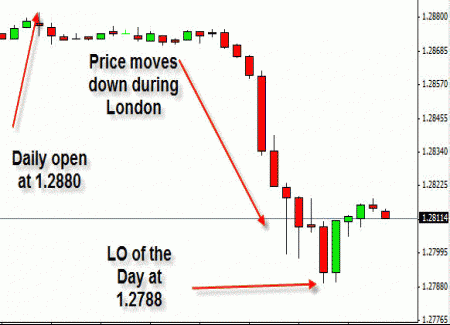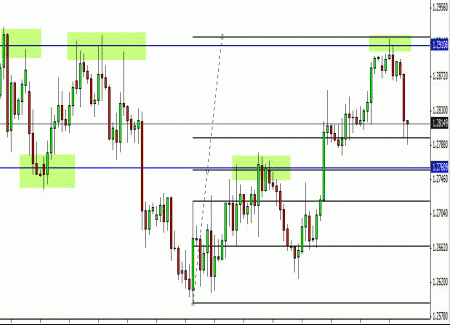Have you ever thought about the daily range of a currency pair? If you have been trading for some time, you know that currency pairs tend to reach the extent of their daily range at some point in the New York session. The truth is that with a bit of technical analysis, a trader can oftentimes determine the general area where a currency pair will be exhausting its daily move, reversing, and trading back into its daily range. This simple, but powerful trading scenario is the backbone of the range expansion reversal strategy. In this article, we will break down the specifics of this trading strategy, and with a little personal tweaking, it could become a valuable part of your overall trading approach.
First let’s break down the idea behind this FX strategy a bit. The Range Expansion Reversal Strategy is essentially a reversion to mean strategy. Reversion to mean is a statistical term that refers to the following mathematical law: over time, data will tend to return to the mean, or average, of the entire data set. Therefore, in this strategy that means that as a currency pair exhausts its daily range each day, it tends to reverse at some point and return back into the average daily range; thus, this strategy is called range expansion reversal strategy-as a currency pair exhausts its average daily range, we are looking to fade the daily momentum in anticipation that the currency pair will return back into its daily range.
Average Daily Range
Currency pairs do not move an infinite amount of pips per day. In fact, under normal market conditions, a currency pair generally moves within a relatively predictable range known as the Average Daily Range. Average Daily Range is calculated as follows:
Determine the Daily Range of A Currency Pair over X number of days
This can be done be done manually, but the best is to use an ADR indicator. Your forex platform should have that available. You should be able to see the ADR over any number of days you choose. It is best to look at the ADR over the last 5, 10, and 20 days. If the numbers are all similar, say 120 pips plus or minus a few pips, then that gives you a good idea that the currency pair is generally moving about 120 pips in current market conditions. Now that you understand how to find the average daily range, let’s break down how to use this information to formulate an actual trading approach for the forex market.
Once you determine the average daily range for a currency pair, then you simply look from the day’s open at midnight and determine where that price area is on the chart. For example, let’s use the EUR/USD and assume that the EUR/USD opens the day at 12:00 am est at a price of 1.2200. You want to let price make its move between 12:00 am and 5:00 am. During this time, the market will begin to form the HI and LO of the day. Take a look at this chart:

You can see the day opened at midnight est at 1.2880. Then as London opened up, price fell to a low of 1.2788 before price moved back up to 1.2811 just prior to the NY Open. Now, during the NY session, you know where price may find support if it keeps moving to the downside or resistance if it moves strongly to the upside. Assuming the ADR is 120 pips, then the euro should find support somewhere around the 1.2760 area. This number is calculated by taking the HI of the day (1.2880) and subtracting 120 pips (ADR). Conversely, if the low at 1.2788 holds and the euro finds lots of buying strength during the NY session and pushes higher, then it should find resistance in the 1.2910 area. This number is calculated by taking the LO of the day (1.2788) and adding 120 pips (ADR). You now have a general idea of where price is going to find either support or resistance during the NY trading session.
The Next Step
Once you pinpoint these potential areas of support and resistance, you want to back out to the higher timeframes (1 Hour and 4 Hour) to see if there is any substantial support/resistance in these price areas that may offer further support for your trading idea. Any number of technical tools can be used, but horizontal support/resistance, Fibonacci retracements/extensions, and pivot points are a few of the best.

The chart above is a 4 Hour Chart. You can see that the resistance level of 1.2910 has quite a bit of resistance. First of all it is the previous swing HI on the 4 Hour Chart, and to the left you can see that this area has acted as strong support for several days. The green shaded boxes show several failed attempts for price to move above this price area.
To the downside you can see that the 1.2760 area we calculated is the 50% fib of the last swing on the 4 Hour Chart, which is quite significant. Also, you can see the green shaded box on the 50% fib level where this 1.2760 area was a strong level of resistance. Now that price has broken through this level, it should act as support if the euro does continue to move down during the NY trading session. You can also see further to the left in the green shaded box that the 1.2760 area has acted as support for price before.
Now, you have a trading plan. You have confirmed support in the 1.2760 area and you have confirmed resistance in the 1.2910 area. As price begins to move to one of these two areas during the NY trading session you are going to be poised and ready to engage the market and fade the daily momentum back into the currency pair’s average daily range.
Now, you should have a solid, basic understanding of the principles behind the Range Expansion Reversal Strategy. In Part 2 of the Range Expansion Reversal Strategy, we will discuss each of the following:
- Entries
- Profit Targets
- Stop Loss
- How To Avoid Potential Losing Trades Using A Few Proprietary Tools
- And more…
Continue to part 2 of the Range Expansion Reversal Strategy
We recommend you to read this article on common technical patterns.
You can also find more information on fibonacci retracements and projections here.
Forextraders' Broker of the Month
BlackBull Markets is a reliable and well-respected trading platform that provides its customers with high-quality access to a wide range of asset groups. The broker is headquartered in New Zealand which explains why it has flown under the radar for a few years but it is a great broker that is now building a global following. The BlackBull Markets site is intuitive and easy to use, making it an ideal choice for beginners.
